Turn a window or glass framed picture into a beautiful DIY faux stained glass window art silhouette. This window art uses glue and acrylic paint to achieve breathtaking colors for a fun art project.

This post is updated from its original publish date of 11/13/2018 in an attempt to address some of the questions asked about the project.
If you love the look of real stained glass, but feel like learning the craft is too difficult, this glass tutorial is for you. Learn how to make faux leaded glass window art with acrylic paint and glue for a fun and cheap stained glass effect.
This DIY project is a great way to create your own large art pieces for your home using an old window. Or start small with the sheet of glass in a photo frame.
This tutorial focuses on how to create a DIY faux stained glass window art silhouette, however creating the faux lead lines of a traditional stained glass picture uses a similar method.
This post contains some affiliate links for your convenience (which means if you click a link and make a purchase I will earn a small commission at no extra cost to you). Please see my disclaimer page for more information.
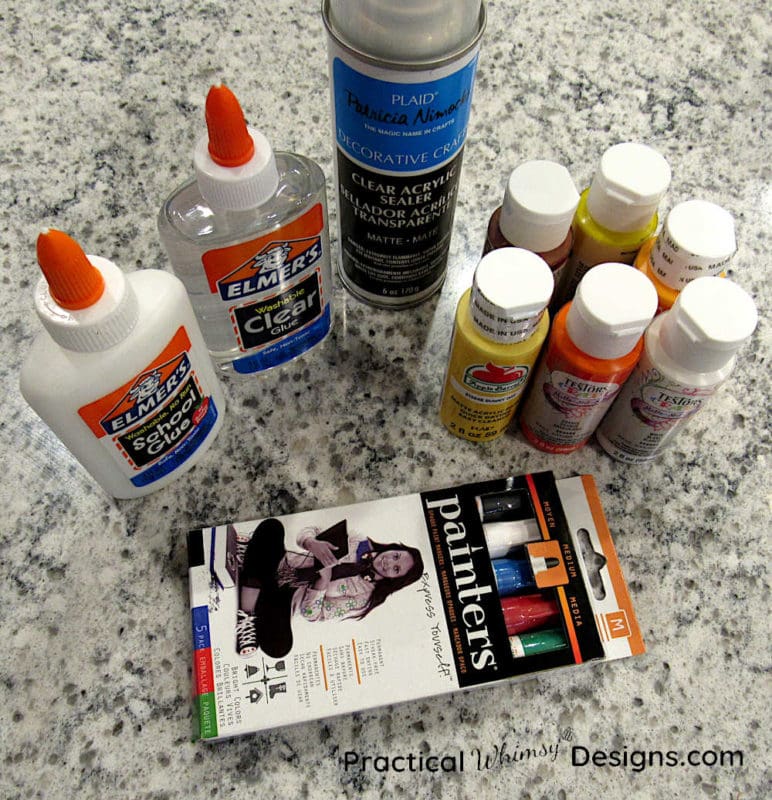
Materials You Need:
- Window (Always check for lead paint before using) or picture frame with glass insert.
- Clear acrylic sealer
- Acrylic paint in the colors you want to use (these will be used for the stained glass background.)
- Black acrylic paint (you need black for your silhouette) it doesn’t matter what finish you use (matte vs. satin) because it is getting mixed into the glue.
- Clear school glue
- One 4 oz. bottle white school glue
- Toothpicks (for popping air bubbles)
- Craft paint brush (Any soft bristle brushes will work)
- Coloring book pages or a black and white print out of your own designs (optional) (This should be the same size as your picture or you can use multiple pictures to create your own unique design.
- Craft knife
- Dry Erase Marker (optional) If you plan on free handing your drawing.
- Paint markers (optional)
6 Steps for Painting a DIY Faux Stained Glass Window Art Silhouette
Step 1: Prepare your glass
The first thing you will want to do is make sure your glass is clean and free of any dust or dirt. Take a rag or paper towel and window cleaner and clean and dry your glass panel.
The next step in preparing your glass is to take the clear acrylic sealer and spray the glass.
Note: You will need to set up an area that is safe from the over spray of the acrylic sealer and is well ventilated.
The goal of the acrylic sealer is to give your glue paint something to adhere to. It will frost the glass a little so you will want to make sure that you only spray the areas you are planning to paint.
Let the glass dry while you mix up the colors you will need for your picture.
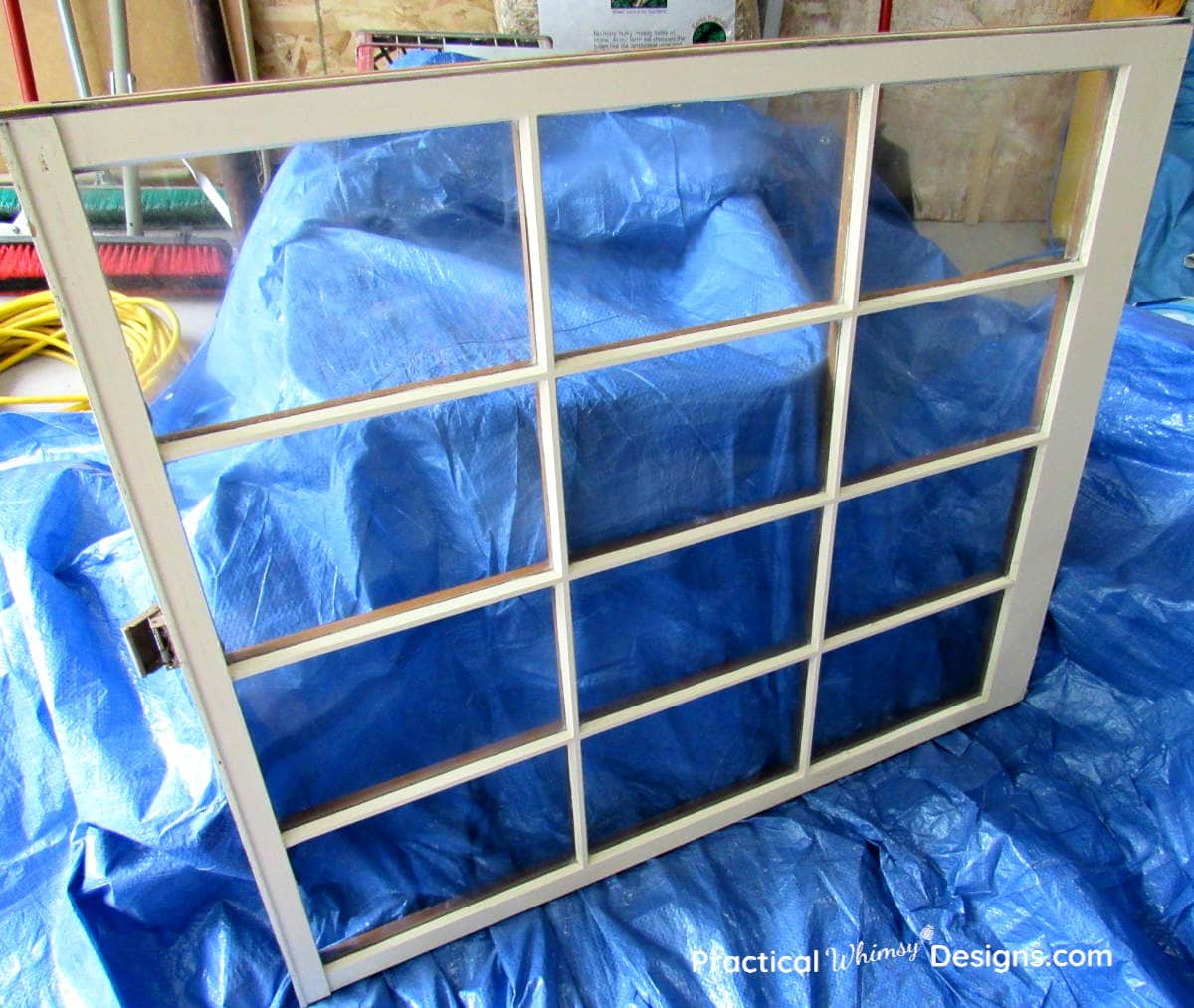
Step 2: Mix Your Paint
Decide which colors you want to use and mix 1-2 drops of acrylic paint in about a tablespoon of clear school glue. For best results, don’t mix too much ahead because glue dries quickly and you don’t want to waste your pretty colors.
I mixed mine in small paper cups so I could easily dispose of them when I was done.
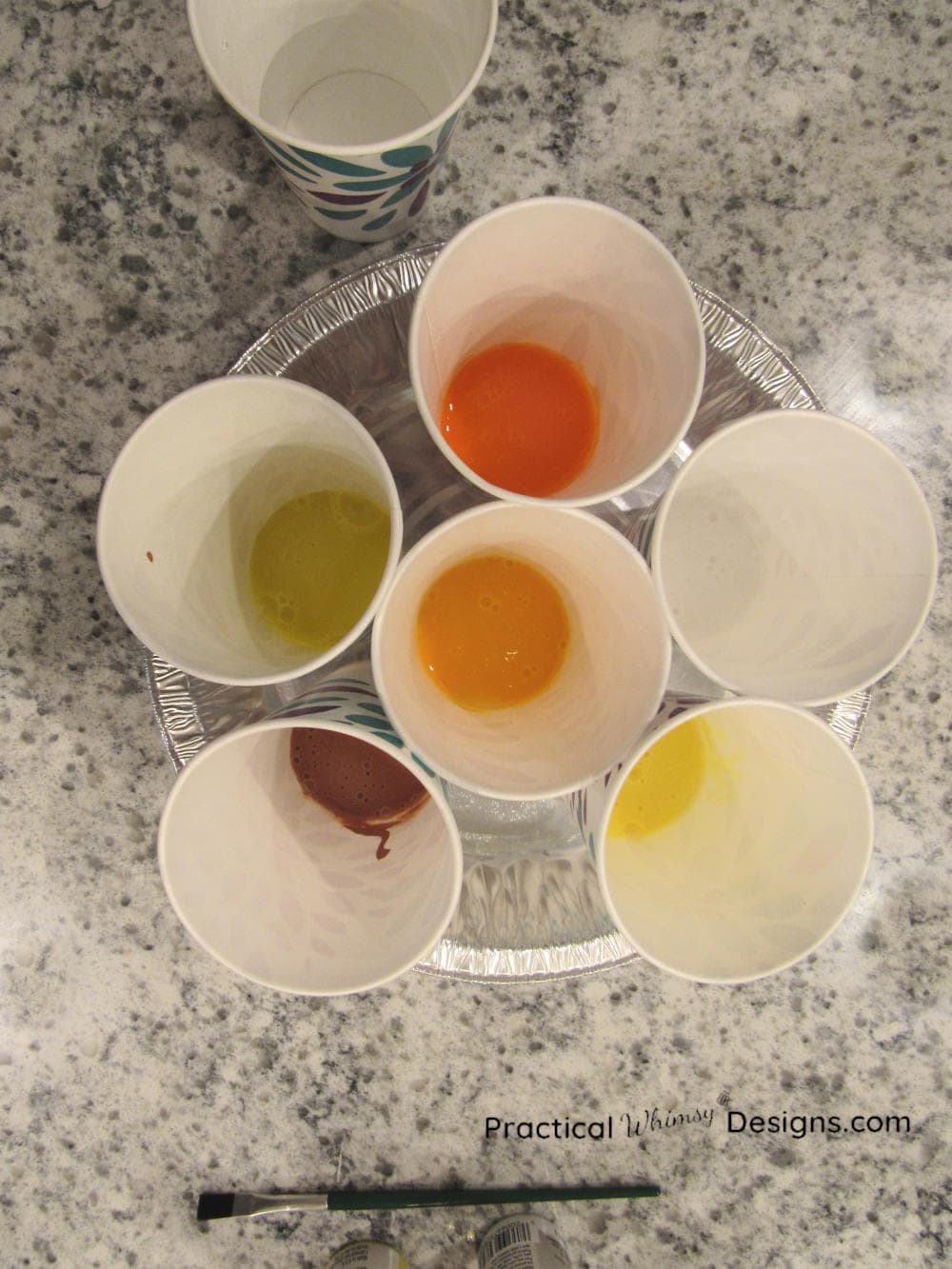
Step 3: Paint the stained glass window art background
Use the different colors you have mixed up to paint the glass of your picture with your craft paint brush. Play around with blending colors or paint everything one color. This part is up to you and your creativity!

Work in small areas at a time so the glue stays wet if you are planning to blend colors. If the glue starts to dry, your brush strokes can pull up the glue paint, leaving clumps in your painting. Don’t worry if this happens. Wait until the glue paint dries all of the way and then go back in with fresh color to fix it.
A couple of tips: If you want a more intense color in a certain area, first paint a layer of glue paint on the glass. Then use straight acrylic paint and paint over the area you want to darken while the glue paint is still wet.
The colors will separate a little because of the glue, so you will have to go back over it with your brush a few times to mix it into the glue.

I used the above method for the sun on my sunrise picture as well as the white and yellow areas on the clouds where I wanted the colors to seem more intense.

Let it dry!
I allowed my painting to dry overnight and it was ready to go the next day.
Need to pick the perfect paint color to go along with your style and decor? Learn how to pick the best paint color for your home and style by signing up for the pdf below.
The form you have selected does not exist.
Step 4: Prep the painting for the silhouette
Grab your white glue and take the lid off. Add 15-20 drops of black acrylic paint to the bottle, put the lid back on, and shake, shake, shake until it is well blended. (This does require a bit of shaking so don’t give up until it is well blended.)
Test a little of the black glue paint to see if it is dark enough and add more paint if you need to.
Note: The glue will look grey when it is wet, but dry black.
Methods you can use to apply your silhouette template.
- The easiest one is to use a printed picture or coloring book page and tape the piece of paper to the back side of your picture. It should be fairly easy to see since the glue paint gives the effect of a see-through stained glass window. If this is your first time, you may want to try your hand at simple designs.
- If you have a bigger piece of glass (like me) then you can either free hand trace a picture on the back of your glass with a dry erase marker,
- Or look at a smaller picture for inspiration and just go for it. It all depends on your comfort level and the size of your glass.
I combined a little of all three methods:
- I drew a basic outline of my tree on the back of my glass to get an idea of the sizing. (Make sure you draw on the BACK of your glass, not on your paint! Then you can wipe it off easily after you have completed your painting.)
- Then I looked at the picture that was my inspiration and free handed the rest.
- I used the paper template method for the words I painted on the left side of my glass design.
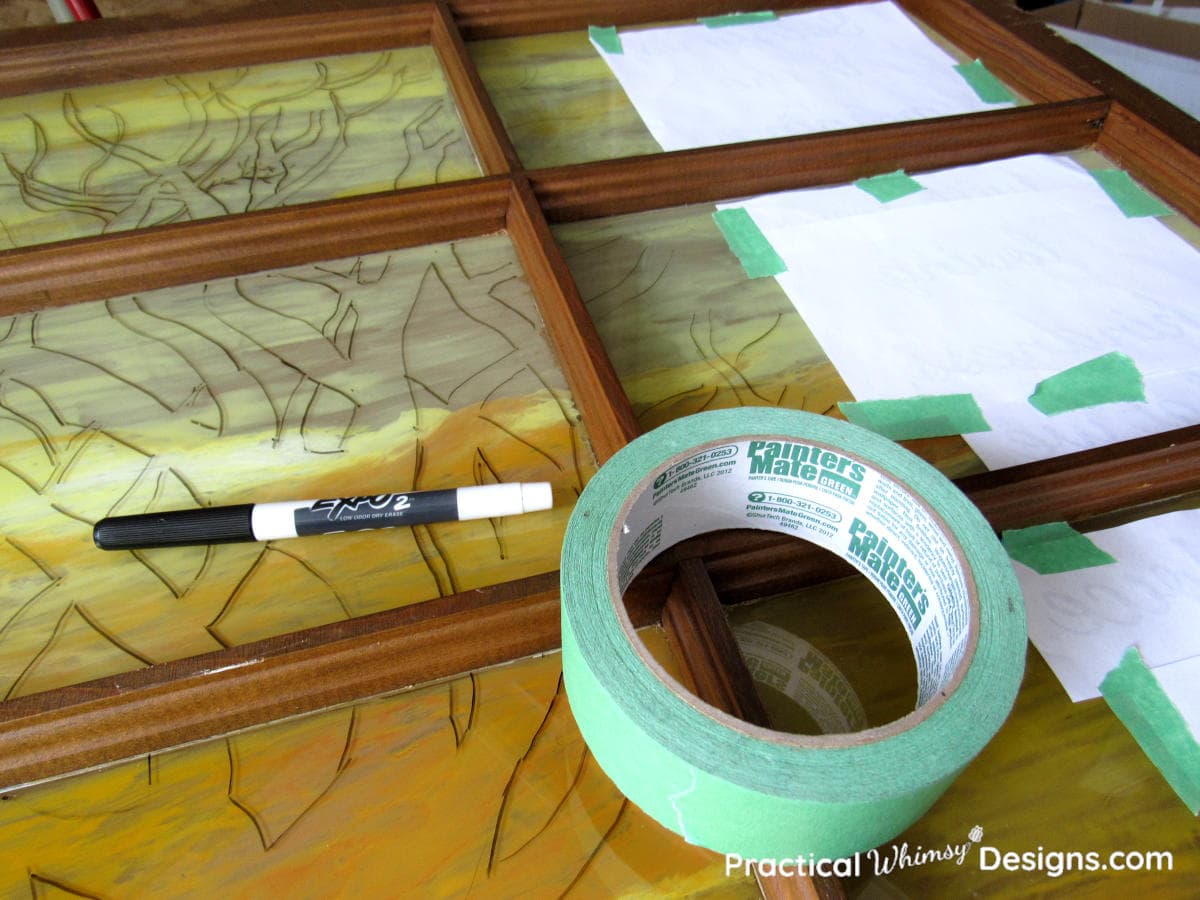
Step 5: Paint the silhouette.
Use the black glue and squeeze your design out onto the side of your glass that you previously painted with the colored glue. Note: This area will dry raised.

Work from top to bottom or side to side, whatever is comfortable. You just don’t want to rub off all of your hard work with your hand.
Pop any air bubbles with a toothpick or the bubbles will dry into little crevices on your painting. Don’t worry, if this does happen (it happened to me), you can come back with your squeeze bottle of extra glue paint and try to blend it in.
As the glue dries, IT WILL SHRINK. Don’t worry if you see some color bleeding through. You can go back over it with more black paint. This has the added bonus of increasing the texture of your silhouette if you are creating a tree or other item that needs a rougher look.
If you do make mistakes, you can use a craft knife to carefully fix the edges. Just don’t get too carried away because you might scratch the paint off your background.
Step 6: Stained glass window art final steps
If you want to add any text to your picture, you can use paint markers. I used black paint markers to write the words on my picture and used a print out taped on the back so I could trace it and keep everything straight.


When you are satisfied with the way it looks, let everything dry for at least a day.
If you drew a white board marker design as your template on the back, wipe it off.
Note: After I had added the silhouette to my tree, I realized that I wanted to add a little blue to my painting. I was able to paint the blue paint over the existing dried glue paint, though I noticed it did pull up the paint underneath if I wasn’t careful. So, if you want to add another color, it can be done. Just proceed with caution so you don’t mess up the other colors on your painting.
This also came in handy when I accidentally scratched some paint off of a little section of glass. The good news was that I could come in and blend in more paint to cover the exposed glass.
How to Seal Faux Stained Glass
You can spray it with clear acrylic sealer after the paint has a chance to dry. This will hopefully help prevent the paint from scratching off. The longer the paint has to cure, the more chance you have of the glue paint remaining on the glass projects you create.
As of the update to this post, my painting has lasted 5 years without scratching and that includes removing and storing it during holidays.
Faux Stained Glass Painting Silhouette
Here is my DIY faux stained glass painting hanging in my living room.

And this is what it looks like with light shining behind it.
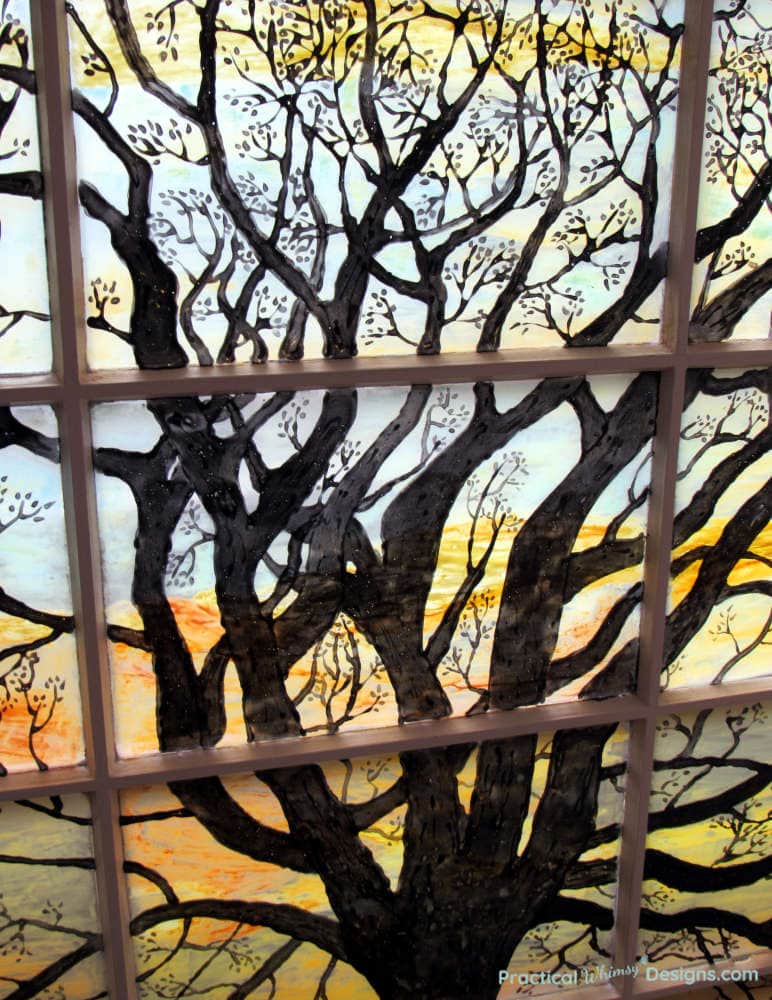
Can you Use This Method to Paint Sun Catchers for Outside?
This project uses water soluble school glue and acrylic paint. It would not stand up to the weather outside. If you hang them in a protected area, such as a porch or under an overhang, they may last longer, but the sun and elements would most likely take their toll.
It may last a little longer if you were able to place the art in between two pieces of glass. I have not tried this method so I can not guarantee its effectiveness.
Is the Faux Stained Glass Painting Removeable?
I am not sure.
Because it took so long to paint, I have not tried removing it from the window and am not sure what the window would look like underneath once the paint glue is removed.
However, if one wanted to remove the painting, I would suggest not spraying it with acrylic sealer.
Use a flat razor to scrap the glue paint off and clean it with glass cleaner.
Again, I have not tested this to see if it works.
Can the Faux Stained Glass Painting go on the Back of a Window?
Yes. However it will be a mirror image so it may not work the greatest for text.

Does the Front and Back of the DIY Faux Stained Glass Art Silhouette Look the Same?
Not quite.
Because the silhouette is painted over the top of the colored clear glue, it is a little harder to see it through the glass on the back side.
If you are wanting both sides to look the same and are not using text, I would create the black outlines first and then add in the color using the method below.

Above is the back side of the painting. As you can see, it is a little harder to see the tree and the text is backwards.
Another DIY Faux Stained Glass Paint Method:
If you are looking for more of a stained glass look, you can apply the black glue paint first to create the traditional lead line look. Let it dry, and then paint with the colored clear glue inside the lines.
You would use the same mixing ratios and methods listed above, but the pictures would turn out more like a stained glass window. It is a little harder to blend your colors with this method, but you can still play around with it.
Note: If you are struggling with your black paint adhering to the glass, even with the acrylic sealer as a base coat, you may have to paint a thin coat of black paint under the area you want to glue. This should give your black glue paint a rougher surface to attach to.
Want to remember this project for later? Save it to your favorite DIY Pinterest board.
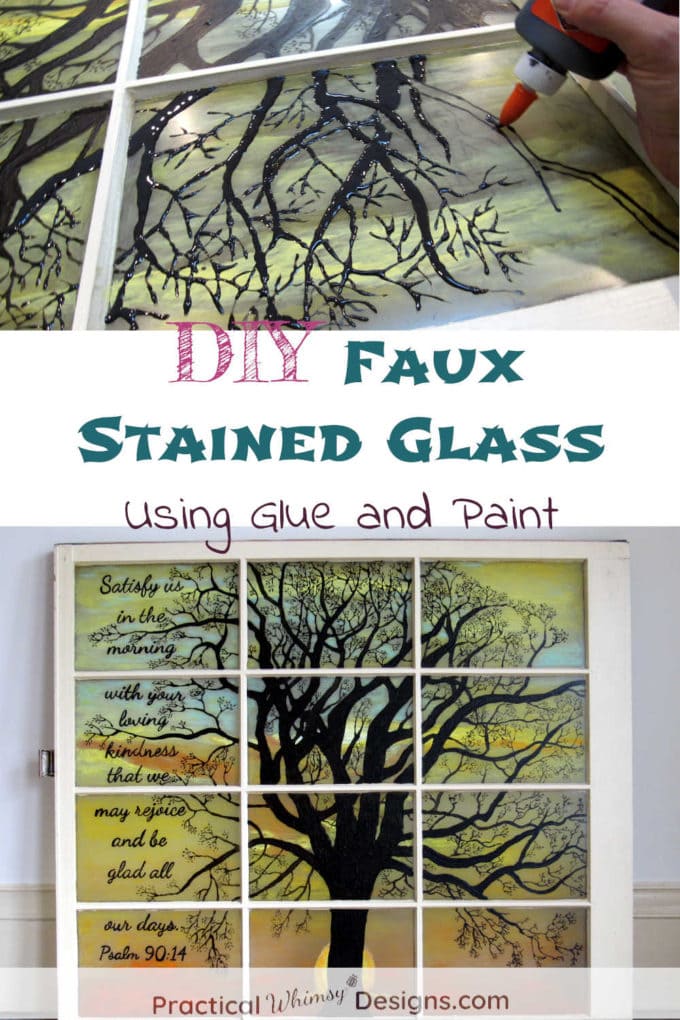
If you try this project, I would love to hear any tips or alternatives you found that work. What was your inspiration?
Looking for more art tutorials? Check out this beginner tutorial on how to paint birch trees on canvas with acrylic paint and how to make a DIY Snowman Lighted Canvas Picture. If you have a Cricut or cutting machine you can transform old art with this DIY love sign upcycle.


Are we friends on Instagram?
Follow @PracticalWhimsyDesigns to see more
behind the scenes projects







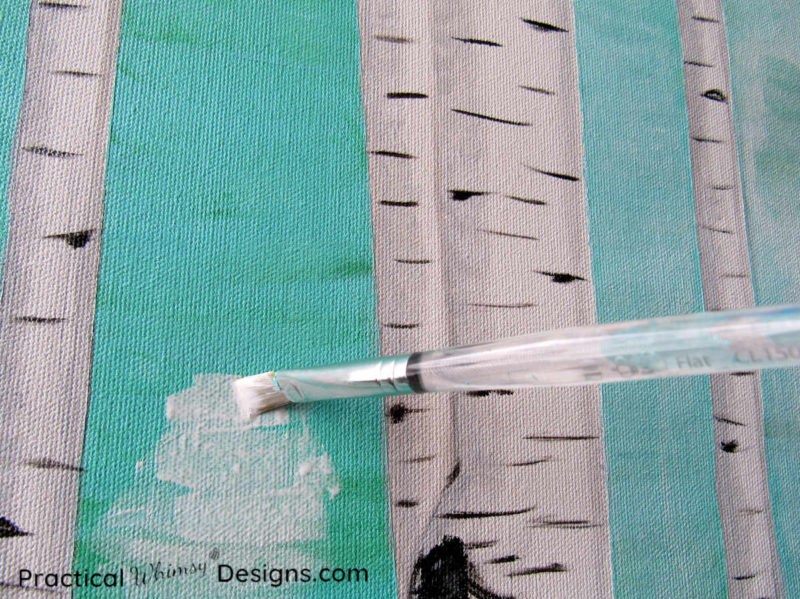


I have looked for this silhouette of the tree you have used. I can’t even find one similar. Do you have a copy I could use for this? Thank you.
Thank you so much for reaching out to me. I am excited that you are interested in trying this project. I actually used a combination of free hand and looking at a silhouette of a tree. Unfortunately, I changed the tree a lot to make it my own so I don’t know if there is anything for you to find online that would be similar. However, I am working on creating a silhouette tree printable based off of my tree picture. I will be notifying my email newsletter list as soon as it is done and it will be available in the free resource library.
This is so pretty! I am going to try it, maybe on something smaller first as I am not very confident! Thanks so much for sharing this tutorial — my mind is spinning!
Thank you so much! I do hope you try your hand at it. There is something so fun about creating your own art and starting on a smaller scale is a great idea. That way it is easier to finish. I am so excited for you to create your own DIY home decor/art project!
When making the stained glass window can I paint everything on the back of the window instead of on the back and front of the window if I’m correct
You can! Just be aware that anything you paint on the other side will be a mirror image. This mostly will affect text, but if you are just painting a picture then you should be fine.
Hi Erin! Am very interested in your technique, would like to try. Could you use this technique for suncatchers outside? ~k
Hi! I am so excited that you want to try this project.
I think using this technique on sun catchers would depend on where you were planning on hanging your sun catcher. Because this project uses school glue and water soluble acrylic paint any moisture would cause the glue to get tacky and come off. If you hung the sun catchers on a covered porch where they couldn’t get wet or sealed the painting in between two pieces of glass, it could work.
I would love to hear if you find a way to make it work.
I have a few old windows, and I want to try your technique, but I’m curious about two things…
1. Why you used both white glue and clear glue.
2. How does the back of the window look in case I want to hang it as a “curtain”
Thank you!
I am so glad that you want to try this project! It has been one of my favorite diy art projects I have done so far.
Great questions! 1) I use 2 types of glue to achieve the stained glass look. The clear glue gives your painting a see through look, like stained glass. The white glue mixed with black is thicker and more opaque, giving the feel of the leaded lines in traditional stained glass.
2) The back of the window looks similar to the front, though it is a mirror image. It is harder to see the silhouette on the back because I painted it over the colored glue. If you are planning on writing text on your window, or using a silhouette, the back will look a little funny because the words will be facing the wrong way and you won’t see as much of the black paint. If you are just planning on painting an image, with no silhouette it should be ok.
I hope this helps!
Great tutorial. I hav a bunch of out of fashion pictures under glass and in nice frames. I am going to use them by removing pictures and backing to have framed faux stained glass items to give as gifts. My question is did you paint on front or back of glass. Thank you.
What a great idea! I did paint them on the front and then sprayed them with acrylic sealer. So far the painting has not gotten scratched at all. I did this because it was easier to put an outline behind the glass and trace it. You could paint the inside of your glass if you are worried about it scratching, however it will show up as a mirror of what you painted on the inside so keep that in mind. I am so glad that you are creating some fun art with your frames.
Are you able to remove it later to do another picture for each season?
I have not tried to remove it because it took a lot of time to make! However, I did accidentally scuff it when I first moved it and the glue came off fairly easily. I had to make a few repairs. Now that it has been sitting longer, I don’t know how easy it would be to remove the glue. And I don’t know what the glass would look like underneath if I peel the glue and paint off. Here are a few thoughts I have, though I have NOT tried any of them. 1) If you are wanting to remove the picture and change it each season I would not prime the window with the acrylic sealer or seal it afterwards. I would think that using a flat razor to scrape the glue off would maybe work. 2)Possibly wetting the painting would cause the glue to come off easier.
Again, I have not tried either of these techniques, so if it is something you were interested in trying, I would test it on a small area first.
I would love to know your results and hear if it works for you.
I bought my supplies today. I made fake backlit windows in my basement and plan to add the Faux stained glass – hopefully changing it seasonally.
When you mentioned above that you painted over the existing dried glue paint, were you staying that you started with a layer of clear glue?
I am so excited that you are going to do this project! The fake backlit windows sound like a great way to use this technique.
I used the white glue mixed with black paint and went over the clear glue mixed with paint, but you can do the black design first and then fill it in with color. For me, it was easier to blend colors without the black lines blocking my painting. I also painted over the existing glue paint when I decided to add a little blue to the sky so I added blue paint to more clear glue and went over a little of the yellow. You do have to be careful when adding more glue because it tends to pull up some of the glue paint you already laid down. I also fixed a little spot on the bottom that got scratched when we moved the painting.
I hope that helps clarify. Please let me know if you have any more questions.
This looks fabulous! I’ll be on the look-out for some old windows now!
Thank you so much! An old glass picture with a pretty frame would also be beautiful. I hope that you have fun creating.
Very nice! Are you for hire?
I haven’t yet, but thank you!